Multifunctional Plasmon-Induced Transparency Devices Based on Hybrid Metamaterial-Waveguide Systems
Abstract
1. Introduction
2. Structural Design
3. Results and Discussion
3.1. Single-PIT (quasi-BIC)
3.2. Double-PIT
3.3. Triple-PIT (Guided Mode)
4. Application
4.1. Index Sensor
4.2. Slow Light Device
5. Conclusions
Author Contributions
Funding
Data Availability Statement
Conflicts of Interest
References
- Fei, Z.; Rodin, A.; Andreev, G.O.; Bao, W.; McLeod, A.; Wagner, M.; Zhang, L.; Zhao, Z.; Thiemens, M.; Dominguez, G.; et al. Gate-tuning of graphene plasmons revealed by infrared nano-imaging. Nature 2012, 487, 82–85. [Google Scholar] [CrossRef] [PubMed]
- He, Z.; Li, C.; Cui, W.; Xue, W.; Li, Z.; Pu, L.; Feng, J.; Xiao, X.; Wang, X.; Liu, Y.; et al. Dual-Fano resonances and sensing properties in the crossed ring-shaped metasurface. Results Phys. 2020, 16, 103140. [Google Scholar] [CrossRef]
- Chiam, S.Y.; Singh, R.; Rockstuhl, C.; Lederer, F.; Zhang, W.; Bettiol, A.A. Analogue of electromagnetically induced transparency in a terahertz metamaterial. Phys. Rev. B 2009, 80, 153103. [Google Scholar] [CrossRef]
- Fu, G.L.; Zhai, X.; Li, H.J.; Xia, S.X.; Wang, L.L. Tunable plasmon-induced transparency based on bright-bright mode coupling between two parallel graphene nanostrips. Plasmonics 2016, 11, 1597–1602. [Google Scholar] [CrossRef]
- Zhang, S.; Genov, D.A.; Wang, Y.; Liu, M.; Zhang, X. Plasmon-induced transparency in metamaterials. Phys. Rev. Lett. 2008, 101, 047401. [Google Scholar] [CrossRef] [PubMed]
- Lin, Q.; Zhai, X.; Wang, L.; Wang, B.; Liu, G.; Xia, S. Combined theoretical analysis for plasmon-induced transparency in integrated graphene waveguides with direct and indirect couplings. EPL 2015, 111, 34004. [Google Scholar] [CrossRef]
- Gu, J.; Singh, R.; Liu, X.; Zhang, X.; Ma, Y.; Zhang, S.; Maier, S.A.; Tian, Z.; Azad, A.K.; Chen, H.T.; et al. Active control of electromagnetically induced transparency analogue in terahertz metamaterials. Nat. Commun. 2012, 3, 1–6. [Google Scholar] [CrossRef]
- Zhang, Z.; Yang, J.; Bai, W.; Han, Y.; He, X.; Huang, J.; Chen, D.; Xu, S.; Xie, W. All-optical switch and logic gates based on hybrid silicon-Ge 2 Sb 2 Te 5 metasurfaces. Appl. Opt. 2019, 58, 7392–7396. [Google Scholar] [CrossRef]
- Ding, J.; Arigong, B.; Ren, H.; Zhou, M.; Shao, J.; Lu, M.; Chai, Y.; Lin, Y.; Zhang, H. Tuneable complementary metamaterial structures based on graphene for single and multiple transparency windows. Sci. Rep. 2014, 4, 1–7. [Google Scholar] [CrossRef]
- Shi, X.; Han, D.; Dai, Y.; Yu, Z.; Sun, Y.; Chen, H.; Liu, X.; Zi, J. Plasmonic analog of electromagnetically induced transparency in nanostructure graphene. Opt. Express 2013, 21, 28438–28443. [Google Scholar] [CrossRef]
- Gao, E.; Li, H.; Liu, Z.; Xiong, C.; Liu, C.; Ruan, B.; Li, M.; Zhang, B. Terahertz multifunction switch and optical storage based on triple plasmon-induced transparency on a single-layer patterned graphene metasurface. Opt. Express 2020, 28, 40013–40023. [Google Scholar] [CrossRef] [PubMed]
- Liu, Z.; Zhang, X.; Zhou, F.; Luo, X.; Zhang, Z.; Qin, Y.; Zhuo, S.; Gao, E.; Li, H.; Yi, Z. Triple plasmon-induced transparency and optical switch desensitized to polarized light based on a mono-layer metamaterial. Opt. Express 2021, 29, 13949–13959. [Google Scholar] [CrossRef] [PubMed]
- Liu, C.; Liu, P.; Yang, C.; Bian, L. Terahertz metamaterial based on dual-band graphene ring resonator for modulating and sensing applications. J. Opt. 2017, 19, 115102. [Google Scholar] [CrossRef]
- Cui, W.; Li, C.; Ma, H.; Xu, H.; Yi, Z.; Ren, X.; Cao, X.; He, Z.; Liu, Z. Excellent sensing based on dual-plasmon induced transparency in graphene metasurface. Phys. E Low-Dimens. Syst. Nanostruct. 2021, 134, 114850. [Google Scholar] [CrossRef]
- Ge, J.; You, C.; Feng, H.; Li, X.; Wang, M.; Dong, L.; Veronis, G.; Yun, M. Tunable dual plasmon-induced transparency based on a monolayer graphene metamaterial and its terahertz sensing performance. Opt. Express 2020, 28, 31781–31795. [Google Scholar] [CrossRef] [PubMed]
- Fan, C.; Jia, Y.; Ren, P.; Jia, W. Tunable plasmon induced transparency and multispectral transparency with large group delay in graphene metamaterials. J. Phys. Appl. Phys. 2020, 54, 035107. [Google Scholar] [CrossRef]
- Zheng, S.; Zhao, Q.; Peng, L.; Jiang, X. Tunable plasmon induced transparency with high transmittance in a two-layer graphene structure. Results Phys. 2021, 23, 104040. [Google Scholar] [CrossRef]
- Lu, C.; Hu, X.; Shi, K.; Hu, Q.; Zhu, R.; Yang, H.; Gong, Q. An actively ultrafast tunable giant slow-light effect in ultrathin nonlinear metasurfaces. Light. Sci. Appl. 2015, 4, e302. [Google Scholar] [CrossRef]
- Niu, X.; Hu, X.; Yan, Q.; Zhu, J.; Cheng, H.; Huang, Y.; Lu, C.; Fu, Y.; Gong, Q. Plasmon-induced transparency effect for ultracompact on-chip devices. Nanophotonics 2019, 8, 1125–1149. [Google Scholar] [CrossRef]
- Abujetas, D.R.; Van Hoof, N.; ter Huurne, S.; Rivas, J.G.; Sánchez-Gil, J.A. Spectral and temporal evidence of robust photonic bound states in the continuum on terahertz metasurfaces. Optica 2019, 6, 996–1001. [Google Scholar] [CrossRef]
- Hsu, C.W.; Zhen, B.; Stone, A.D.; Joannopoulos, J.D.; Soljačić, M. Bound states in the continuum. Nat. Rev. Mater. 2016, 1, 1–13. [Google Scholar] [CrossRef]
- Zhao, X.; Chen, C.; Kaj, K.; Hammock, I.; Huang, Y.; Averitt, R.D.; Zhang, X. Terahertz investigation of bound states in the continuum of metallic metasurfaces. Optica 2020, 7, 1548–1554. [Google Scholar] [CrossRef]
- Niu, J.; Zhai, Y.; Han, Q.; Liu, J.; Yang, B. Resonance-trapped bound states in the continuum in metallic THz metasurfaces. Opt. Lett. 2021, 46, 162–165. [Google Scholar] [CrossRef] [PubMed]
- Abujetas, D.R.; Barreda, Á.; Moreno, F.; Litman, A.; Geffrin, J.M.; Sánchez-Gil, J.A. High-Q Transparency Band in All-Dielectric Metasurfaces Induced by a Quasi Bound State in the Continuum. Laser Photonics Rev. 2021, 15, 2000263. [Google Scholar] [CrossRef]
- Khanikaev, A.B.; Wu, C.; Shvets, G. Fano-resonant metamaterials and their applications. Nanophotonics 2013, 2, 247–264. [Google Scholar] [CrossRef]
- Ordal, M.A.; Bell, R.J.; Alexander, R.W.; Long, L.L.; Querry, M.R. Optical properties of fourteen metals in the infrared and far infrared: Al, Co, Cu, Au, Fe, Pb, Mo, Ni, Pd, Pt, Ag, Ti, V, and W. Appl. Opt. 1985, 24, 4493–4499. [Google Scholar] [CrossRef] [PubMed]
- Hanson, G.W. Dyadic Green’s functions and guided surface waves for a surface conductivity model of graphene. J. Appl. Phys. 2008, 103, 064302. [Google Scholar] [CrossRef]
- Cheng, H.; Chen, S.; Yu, P.; Duan, X.; Xie, B.; Tian, J. Dynamically tunable plasmonically induced transparency in periodically patterned graphene nanostrips. Appl. Phys. Lett. 2013, 103, 203112. [Google Scholar] [CrossRef]
- Chen, J.H.; Jang, C.; Xiao, S.; Ishigami, M.; Fuhrer, M.S. Intrinsic and extrinsic performance limits of graphene devices on SiO2. Nat. Nanotechnol. 2008, 3, 206–209. [Google Scholar] [CrossRef]
- Chu, H.S.; How Gan, C. Active plasmonic switching at mid-infrared wavelengths with graphene ribbon arrays. Appl. Phys. Lett. 2013, 102, 231107. [Google Scholar] [CrossRef]
- Suh, W.; Wang, Z.; Fan, S. Temporal coupled-mode theory and the presence of non-orthogonal modes in lossless multimode cavities. IEEE J. Quantum Electron. 2004, 40, 1511–1518. [Google Scholar]
- Chen, H.; Liu, J.; Hong, Z. Guided mode resonance with extremely high Q-factors in terahertz metamaterials. Opt. Commun. 2017, 383, 508–512. [Google Scholar] [CrossRef]
- Dong, Z.G.; Ni, P.G.; Zhu, J.; Zhang, X. Transparency window for the absorptive dipole resonance in a symmetry-reduced grating structure. Opt. Express 2012, 20, 7206–7211. [Google Scholar] [CrossRef] [PubMed]
- Wang, S.; Magnusson, R. Theory and applications of guided-mode resonance filters. Appl. Opt. 1993, 32, 2606–2613. [Google Scholar] [CrossRef]
- Tikhodeev, S.G.; Yablonskii, A.; Muljarov, E.; Gippius, N.A.; Ishihara, T. Quasiguided modes and optical properties of photonic crystal slabs. Phys. Rev. B 2002, 66, 045102. [Google Scholar] [CrossRef]
- Koller, D.; Hohenester, U.; Hohenau, A.; Ditlbacher, H.; Reil, F.; Galler, N.; Aussenegg, F.; Leitner, A.; Trügler, A.; Krenn, J. Superresolution Moiré mapping of particle plasmon modes. Phys. Rev. Lett. 2010, 104, 143901. [Google Scholar] [CrossRef]
- Yannopapas, V.; Stefanou, N. Optical excitation of coupled waveguide-particle plasmon modes: A theoretical analysis. Phys. Rev. B 2004, 69, 012408. [Google Scholar] [CrossRef]
- Zhao, X.; Yuan, C.; Zhu, Y.; Chen, X.; Zhu, L. Controlling the interaction between plasmon-induced transparency and guided mode resonance. Opt. Express 2017, 25, 30043–30050. [Google Scholar] [CrossRef]
- Wang, B.X.; Zhai, X.; Wang, G.Z.; Huang, W.Q.; Wang, L.L. A novel dual-band terahertz metamaterial absorber for a sensor application. J. Appl. Phys. 2015, 117, 014504. [Google Scholar] [CrossRef]
- Chen, X.; Fan, W. Ultrasensitive terahertz metamaterial sensor based on spoof surface plasmon. Sci. Rep. 2017, 7, 1–8. [Google Scholar] [CrossRef]
- Vanani, F.G.; Fardoost, A.; Safian, R. Graphene Based Double Ring Label-Free Terahertz Sensor with High Sensitivity. In Proceedings of the Optics and Photonics for Sensing the Environment, San Jose, CA, USA, 25–27 June 2019. [Google Scholar]
- Chen, C.Y.; Yang, Y.H.; Yen, T.J. Unveiling the electromagnetic responses of fourfold symmetric metamaterials and their terahertz sensing capability. Appl. Phys. Express 2013, 6, 022002. [Google Scholar] [CrossRef]
- Zhao, Z.; Zhao, H.; Ako, R.T.; Zhang, J.; Zhao, H.; Sriram, S. Demonstration of group delay above 40 ps at terahertz plasmon-induced transparency windows. Opt. Express 2019, 27, 26459–26470. [Google Scholar] [CrossRef] [PubMed]
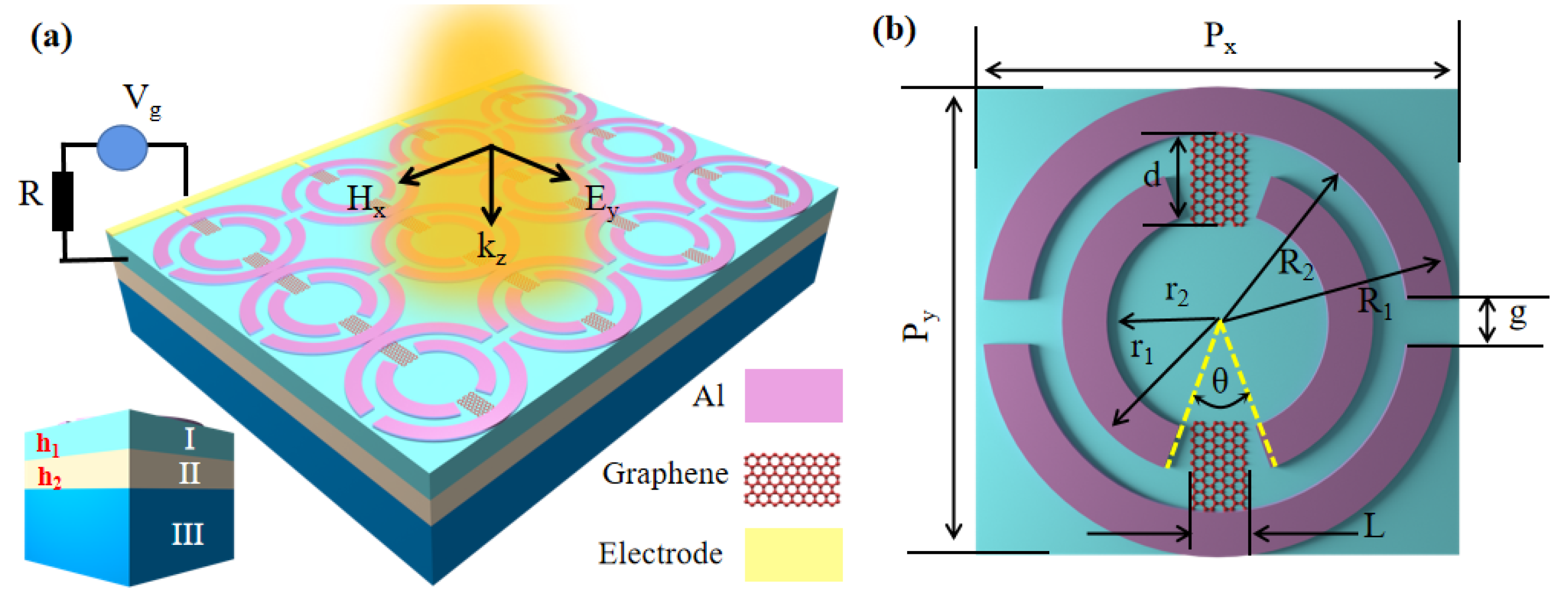
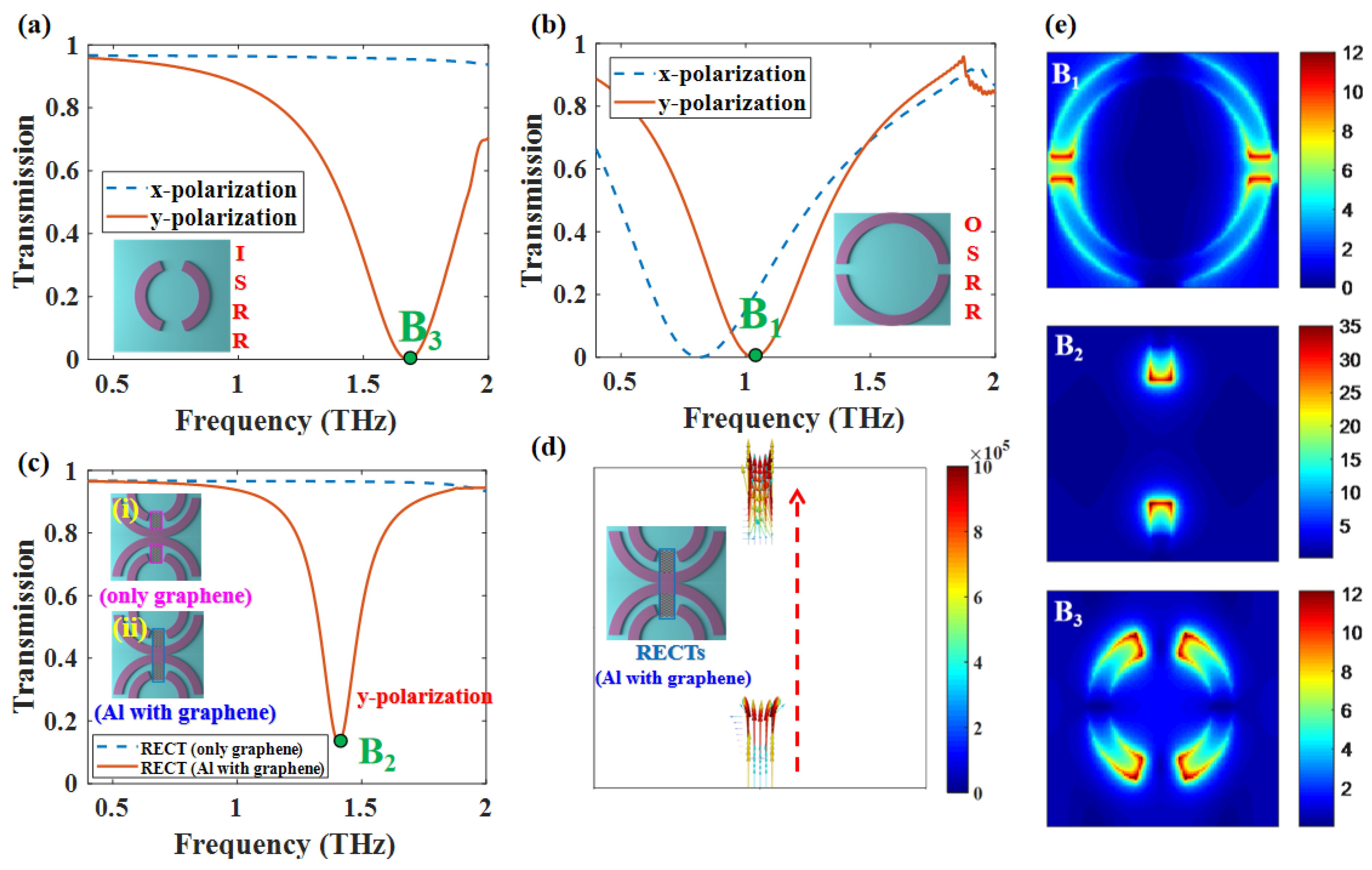
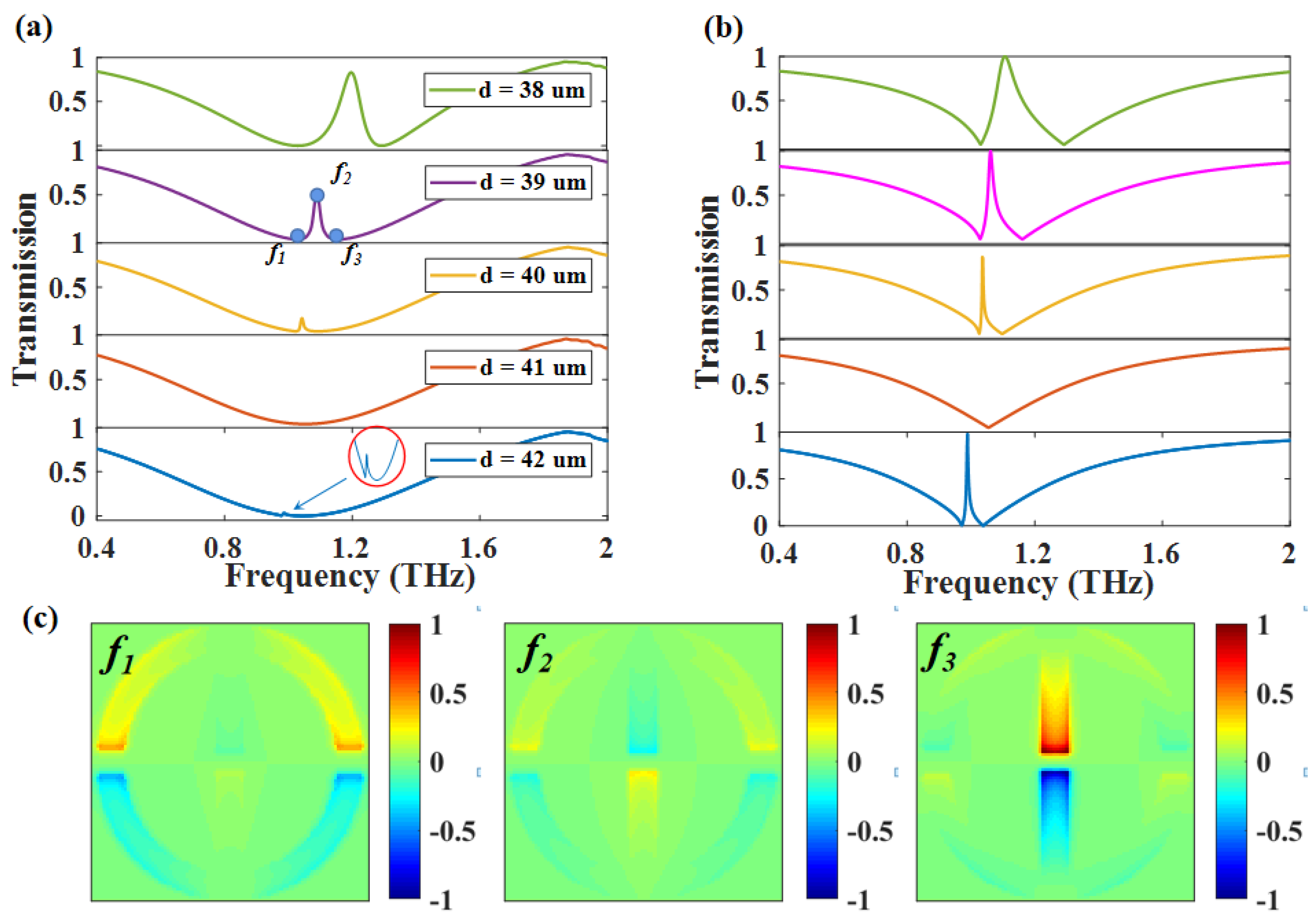
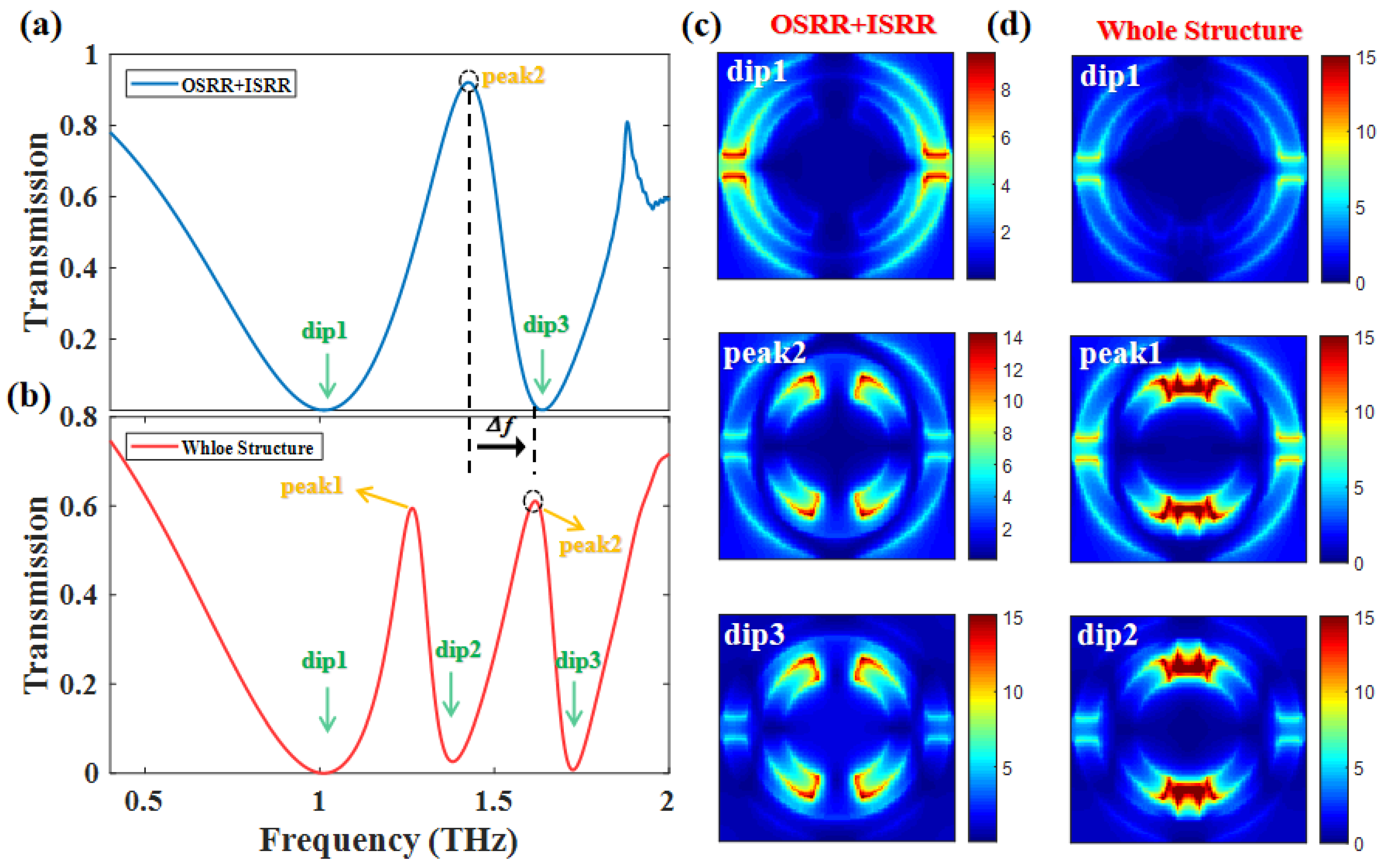
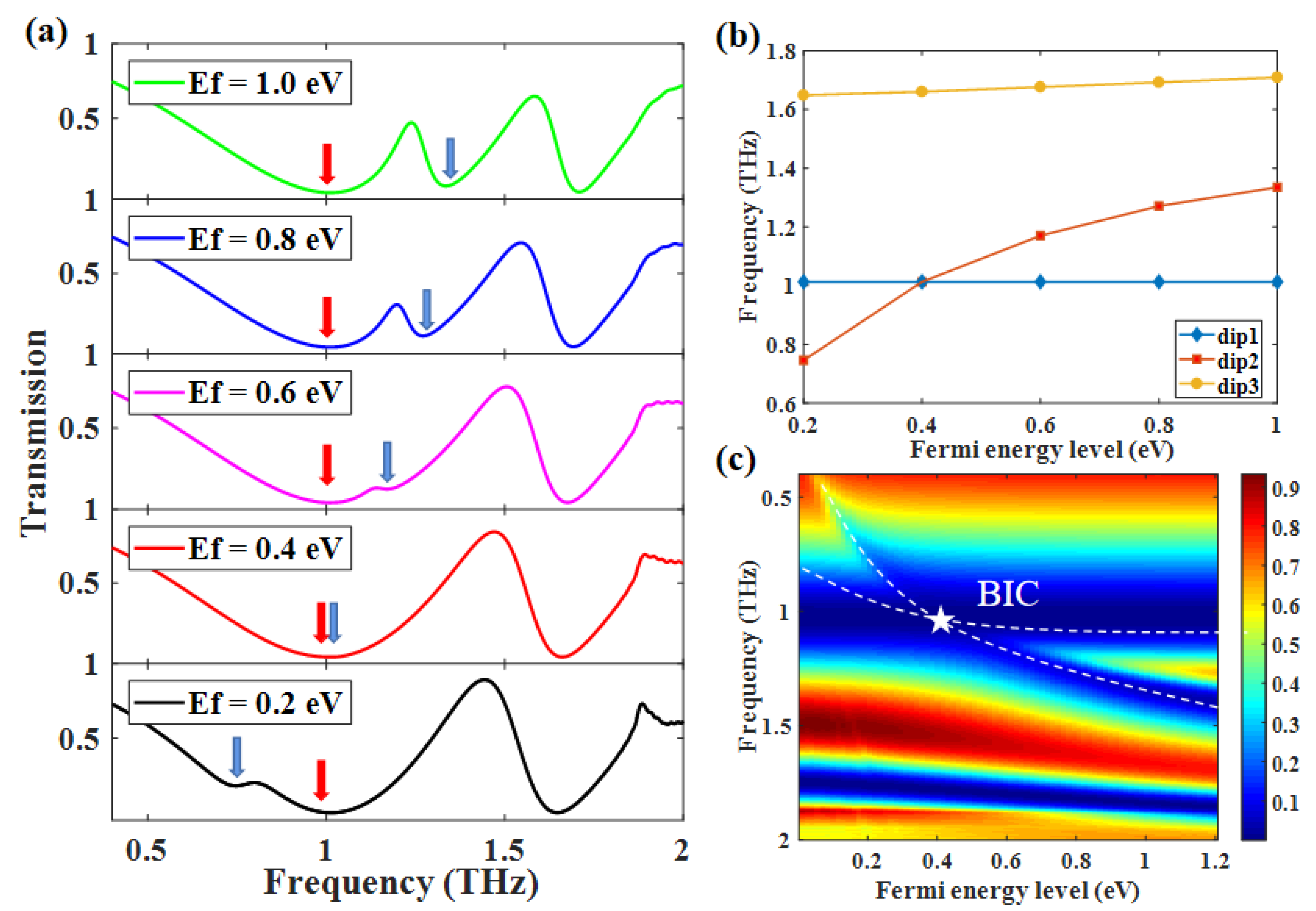
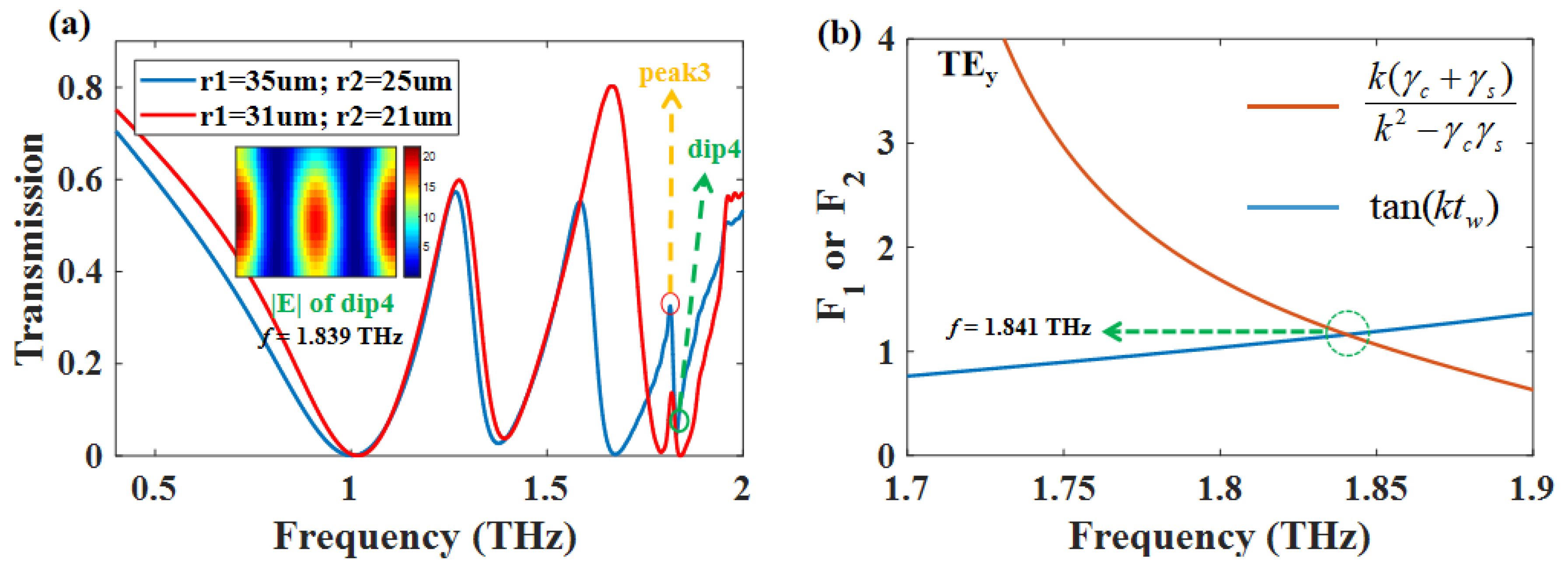
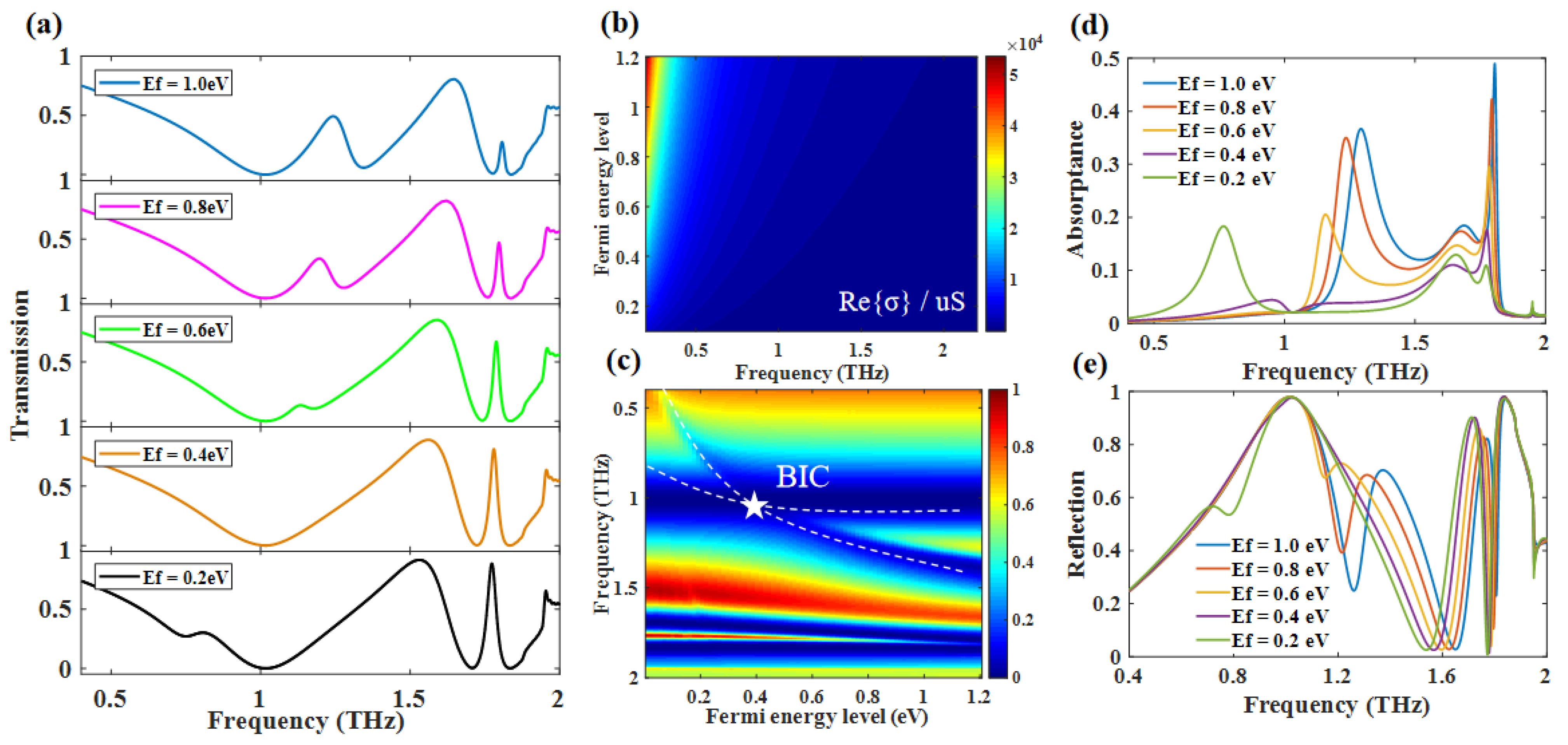
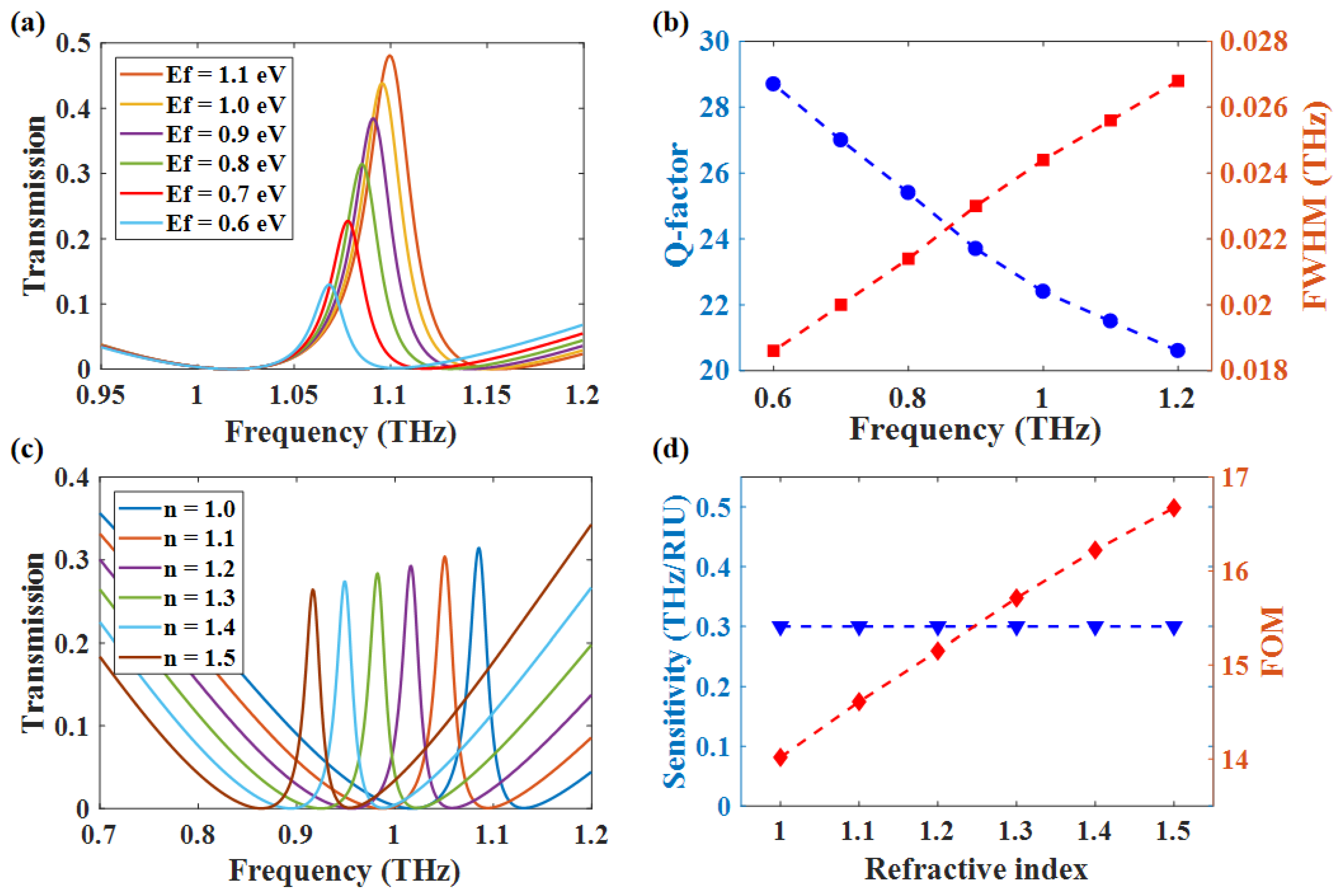
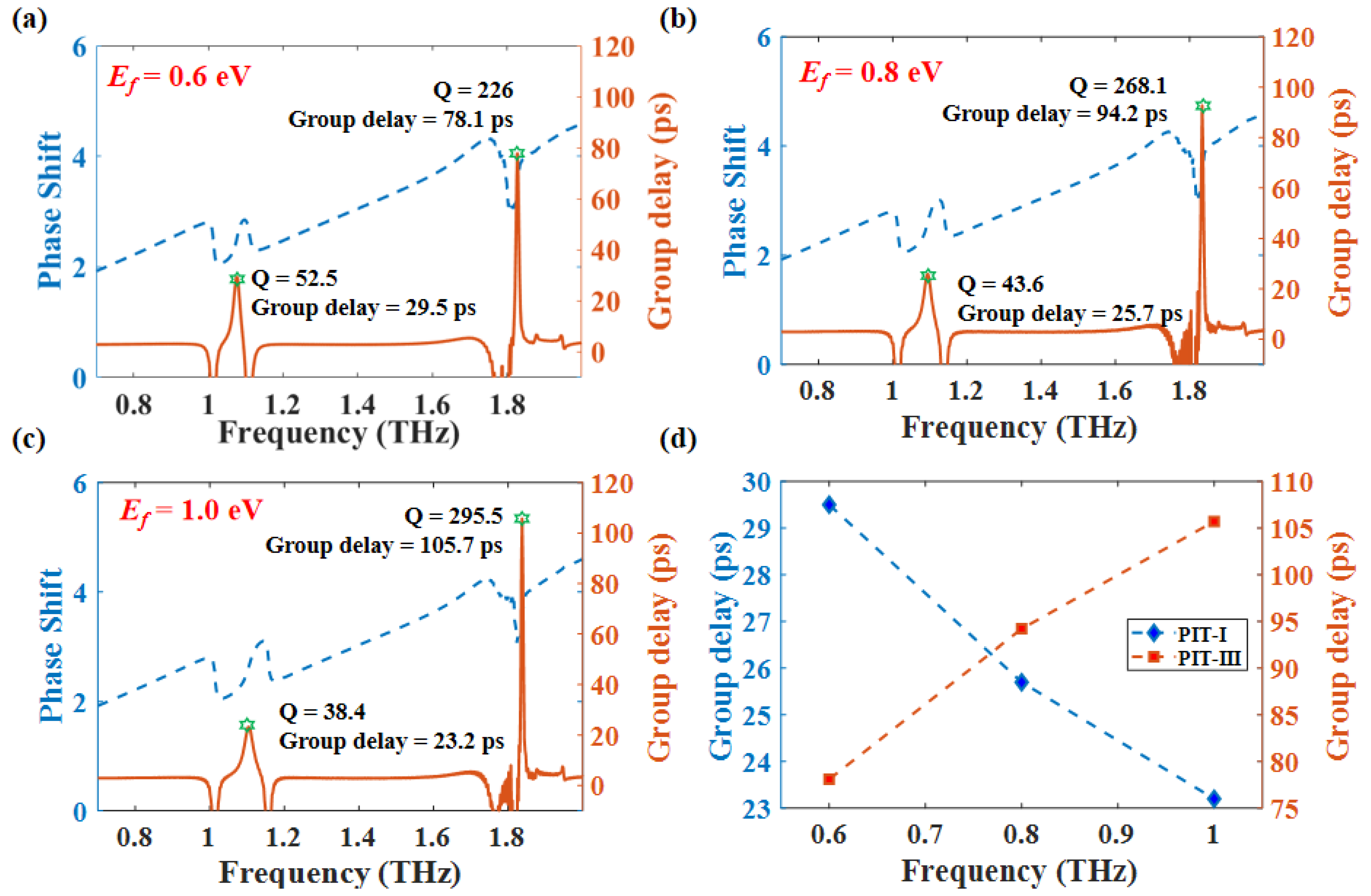
Publisher’s Note: MDPI stays neutral with regard to jurisdictional claims in published maps and institutional affiliations. |
© 2022 by the authors. Licensee MDPI, Basel, Switzerland. This article is an open access article distributed under the terms and conditions of the Creative Commons Attribution (CC BY) license (https://creativecommons.org/licenses/by/4.0/).
Share and Cite
Chen, H.; Zhang, Z.; Zhang, X.; Han, Y.; Zhou, Z.; Yang, J. Multifunctional Plasmon-Induced Transparency Devices Based on Hybrid Metamaterial-Waveguide Systems. Nanomaterials 2022, 12, 3273. https://doi.org/10.3390/nano12193273
Chen H, Zhang Z, Zhang X, Han Y, Zhou Z, Yang J. Multifunctional Plasmon-Induced Transparency Devices Based on Hybrid Metamaterial-Waveguide Systems. Nanomaterials. 2022; 12(19):3273. https://doi.org/10.3390/nano12193273
Chicago/Turabian StyleChen, Hongting, Zhaojian Zhang, Xiao Zhang, Yunxin Han, Zigang Zhou, and Junbo Yang. 2022. "Multifunctional Plasmon-Induced Transparency Devices Based on Hybrid Metamaterial-Waveguide Systems" Nanomaterials 12, no. 19: 3273. https://doi.org/10.3390/nano12193273
APA StyleChen, H., Zhang, Z., Zhang, X., Han, Y., Zhou, Z., & Yang, J. (2022). Multifunctional Plasmon-Induced Transparency Devices Based on Hybrid Metamaterial-Waveguide Systems. Nanomaterials, 12(19), 3273. https://doi.org/10.3390/nano12193273








